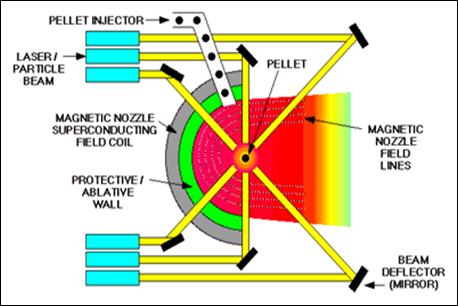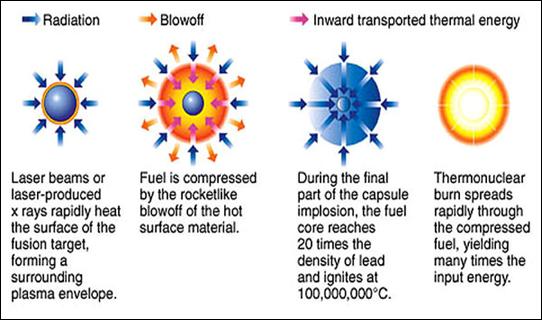





Published on Apr 02, 2024
Spacecraft propulsion is used to change the velocity of spacecraft and artificial satellites. There are many different methods. Each method has drawbacks and advantages, and spacecraft propulsion is an active area of research. Most spacecraft today are propelled by heating a reaction mass to high temperatures and exhausting it from the back/rear of the vehicle at very high speed. This sort of engine is called a rocket engine.
Artificial satellites must be launched into orbit, and once there they must be placed in their nominal orbit. Once in the desired orbit, they often need some form of attitude control so that they are correctly pointed with respect to the Earth, the Sun, and possibly some astronomical object of interest. They are also subject to drag from the thin atmosphere, so that to stay in orbit for a long period of time some form of propulsion is occasionally necessary to make small corrections (orbital stationkeeping). Many satellites need to be moved from one orbit to another from time to time, and this also requires propulsion. When a satellite has exhausted its ability to adjust its orbit, its useful life is over.
Specraft esigned to travel further also need propulsion methods. They need to be launched out of the Earth's atsphere st as satellites do. Once there, they need to leave orbit and move around.
For interplanetary travel, a spacecraft must use its engines to leave Earth orbit. Once it has done so, it must somehow make its way to its destination. Current interplanetary spacecraft do this with a series of short-term orbital adjustments. In between these adjustments, the spacecraft simply falls freely along its orbit. The simplest fuel-efficient means to move from one circular orbit to another is with a Hohmann transfer orbit: the spacecraft begins in a roughly circular orbit around the Sun. A short period of thrust in the direction of motion accelerates or decelerates the spacecraft into an elliptical orbit around the Sun which is tangential to its previous orbit and also to the orbit of its destination.
The spacecraft falls freely along this elliptical orbit until it reaches its destination, where another short period of thrust accelerates or decelerates it to match the orbit of its destination. Special methods such as aerobraking are sometimes used for this final orbital adjustment.Some spacecraft propulsion methods such as solar sails provide very low but inexhaustible thrust; an interplanetary vehicle using one of these methods would follow a rather different trajectory, either constantly thrusting against its direction of motion in order to decrease its distance from the Sun or constantly thrusting along its direction of motion to increase its distance from the Sun.
Spacecraft for interstellar travel also need propulsion methods. No such spacecraft has yet been built, but many designs have been discussed. Since interstellar distances are very great, a tremendous velocity is needed to get a spacecraft to its destination in a reasonable amount of time. Acquiring such a velocity on launch and getting rid of it on arrival will be a formidable challenge for spacecraft designers
Fusion comes from the word fuse. Fusion occurs when two nuclei combine to from a new nucleus. In the diagram shown below, we are looking at a depiction of two hydrogen nuclei fusing to form a Helium nucleus. We see fusion everyday. Fusion causes the energy release, and therefore the light we see from the sun and the stars. Nuclear fusion which is much cleaner which has no radioactive by-products as that of fission and has a higher energy density, about 108 (10^8 or 100 million) times greater than current chemical systems. The energy released in most nuclear reactions is much larger than that for chemical reactions, because the binding energy that holds a nucleus together is far greater than the energy that holds electrons to a nucleus. For example, the ionization energy gained by adding an electron to hydrogen is 13.6 electron volts -- less than one-millionth of the 17 MeV released in the D-T (deuterium-tritium) reaction shown in below.
D + T → 4He (3.5 MeV) + n (14.1 MeV)
Fusion occurs at a sufficient rate only at very high energies (temperatures) - on earth, temperatures greater than 100 million Kelvin are required. At these extreme temperatures, the Deuterium - Tritium (D-T) gas mixture becomes a plasma (a hot, electrically charged gas). In a plasma, the atoms become separated - electrons have been stripped from the atomic nuclei (called the "ions"). For the positively charged ions to fuse, their temperature (or energy) must be sufficient to overcome their natural charge repulsion
Since no fossil fuels are used, there will be no release of chemical combustion products because they will not be produced. Similarly, there will be no fission products formed to present a handling and disposal problem. Radioactivity will be produced by neutrons interacting with the reactor structure, but careful materials selection is expected to minimize the handling and ultimate disposal of activated materials
Mainly uses deuterium and tritium as the fusion fuel
Heavy isotope of hydrogen in which the nucleus contains one proton and one neutron (compared with ordinary hydrogen’s single proton). The abundance of deuterium in interstellar space is about 1.4 × 10-5 that of hydrogen. Because deuterium is difficult to manufacture and is quickly destroyed in stellar nuclear reactions, one view is that most of the deuterium found in the universe today was formed in the Big Bang. It is an important fuel for nuclear fusion
Tritium, as a form of Hydrogen, is found naturally in air and water. Most hydrogen is made up of one proton, and an orbital electron, but tritium has two extra neutrons in the nucleus
ICF, sometimes referred to as pulsed fusion, is a different idea based on the same principle, in this case a tiny plasma, a thousand trillion times more dense than that used in MCF, is created by using blasts from lasers to rapidly superheat fuel pellets. This plasma then rapidly expands and, due to an equal and opposite momentum reaction, compresses the fuel pellets (which increases the fusion reaction rate). This combination of laser and the compression produces enough heat to induce fusion to occur.

This system requires no heat containment, as the reaction is so rapid. This means there is no need for the magnetic fields; the pellet's own inertia should confine the heat long enough for a fusion reaction. There also exists the possibility that particle beams could be used instead of lasers, as they are more efficient.
A pellet of fusion fuel is bombarded on all sides by strong pulses from laser or particle accelerators. The inertia of the fuel holds it together long enough for most of it to undergo fusion.

In inertial confinement fusion (ICF), nuclear fusion reactions are initiated by heating and compressing a target – a pellet that most often contains deuterium and tritium – by the use of intense laser or ion beams. The beams explosively detonate the outer layers of the target, accelerating the remaining target layers inward and sending a shock wave into the center. If the shock wave is powerful enough and if high enough density at the center is achieved some of the fuel will be heated enough to cause fusion reactions, releasing energy. In a target which has been heated and compressed to the point of thermonuclear ignition, energy can then heat surrounding fuel to cause it to fuse as well, creating a chain reaction that burns the fuel load, potentially releasing tremendous amounts of energy. Theoretically, if the reaction completes with perfect efficiency , a small amount of fuel about the size of a pinhead releases the energy equivalent to a barrel of oil.
This propulsion system would operate by detonating pellets in a chamber at the rear of the vehicle using lasers. Detonation will have to occur at a rate of anywhere between 30 and 250 per second. And this ICF produce tremendous amount of energy which is exhausted. ICF operates at a much higher density than MCF but it should be noted that the required banks of lasers are likely to be heavy, power intensive devices, though probably less so than the magnets in MFC
| Are you interested in this topic.Then mail to us immediately to get the full report.
email :- contactv2@gmail.com |